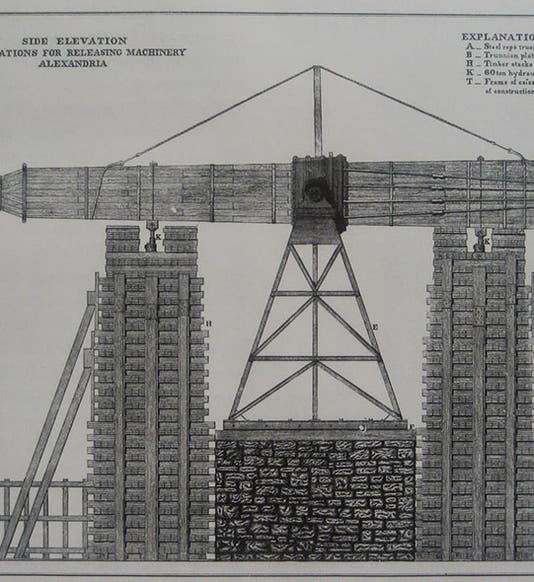Scientist of the Day - Richard Dudgeon
Richard Dudgeon, a Scottish-American machinist, died Apr. 8, 1895, at the age of around 76; his birth date is unknown. Dudgeon came to New York at a young age from Scotland and, being mechanically gifted, was soon working in various shops in New York City. In 1851, he invented what he called a "portable hydraulic press", which indeed it was, although we would now call it a hydraulic jack. This was the first new heavy-lifting device since the jack-screw, which the Romans had used 1800 years earlier. Work the pump-handle a few dozen times and one could raise 100 tons into the air (or slowly lower it to the ground). When Henry Gorringe, in 1879-81, lowered the Cleopatra Needle obelisk in Alexandria, Egypt, and then raised it again in Central Park in New York City, he used two Dudgeon jacks to do the lowering and raising (first image; you can see both jacks on top of the stacks of wooden timbers, just below the obelisk; a third Dudgeon jack was encased in lead and buried in the time capsule beneath the obelisk in Central Park).
Dudgeon's other technical innovation was a steam road carriage. He was not the first to make one (see our post on Nicolas-Joseph Cugnot), but his seems to have been the first that was actually functional. It was built by 1857 and Dudgeon would drive it from his home to his shop, in spite of the protests of passers-by and horses (he said he invented the device because he wanted to end the cruel treatment of horses by carriage owners, but I am not sure the horses appreciated this). Unfortunately for Dudgeon, in 1858 he put his wagon on temporary display in the New York Crystal Palace, built in 1853 in emulation of the original Crystal Palace in London, and on Oct. 5, 1858, the strangely flammable steel and glass fabric of the New York Palace burned to the ground, taking the steam carriage with it.
In 1866, Dudgeon built a second steam wagon; this one he tried to sell, but he had no takers. However, Dudgeon Carriage no. 2 survived; it had its photograph taken (second image), and was then passed down to his son, then his grandson, then the grandson's widow (who lent it to the 1939 World’s fair – apparently family memories were short), then to several vintage car buffs, one of whom ultimately presented it to the Smithsonian Institution, where it is now part of the collection of the National Museum of American History, although no longer on display. Here is a recent photograph.
We apologize again for the fact that we have been limited to two images during the interim, for we would have liked to include here a painting of Dudgeon’s steam carriage made by Carl Rakeman, the resident artist at the national Bureau of Public Roads (BPR) for thirty years, 1921-52. Rakeman painted an entire series of “great moments in the history of American highways.” The Federal Highway Administration (FHWA), the successor to the BPR, has posted all of them online. People seem to have mixed feelings about Rakeman’s art – he tends to appeal to those who like Norman Rockwell, and not to those who don’t – but we have to give the man his due: in his efforts to document the history of the American road, he recreated historical scenes that no other artist paid any attention to. Thus some years ago, when we featured, as Scientist of the Day, Peter Cooper, whose iron horse Tom Thumb raced a flesh-and-blood horse in 1830, we illustrated the event with a Rakeman painting – otherwise, we would have had no image at all. And I think Rakeman’s painting of Dudgeon’s steam carriage of 1866 is one of his better efforts. You can see it here, and you will find an index to all of Rakeman’s paintings here.
The other image we would have liked to include is a U.S. postage stamp of 1991 that commemorated Dudgeon’s steam carriage of 1866. You can see it on Arago, the excellent website of the Smithsonian National Postal Museum.
Dr. William B. Ashworth, Jr., Consultant for the History of Science, Linda Hall Library and Associate Professor emeritus, Department of History, University of Missouri-Kansas City. Comments or corrections are welcome; please direct to ashworthw@umkc.edu.




![“Aurora Borealis,” hand-colored wood engraving by Josiah Wood Whymper, [Natural Phenomena], plate 2, 1846 (Linda Hall Library)](https://assets-us-01.kc-usercontent.com:443/9dd25524-761a-000d-d79f-86a5086d4774/0245ffcb-b70c-477c-8792-0a73ebd54eb2/Whymper%2011.jpg?w=210&h=210&auto=format&fit=crop)


